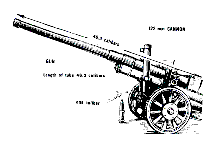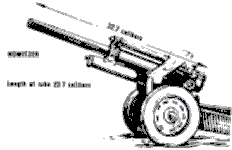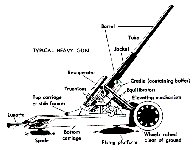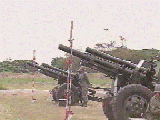






 Modern advances in armament and technology continue to drive the development and application of combined arms doctrine. The integration of artillery assets into a unified fire support plan is a major task for the combined arms commander. Integration is also fundamental to the success of any operation.
Modern advances in armament and technology continue to drive the development and application of combined arms doctrine. The integration of artillery assets into a unified fire support plan is a major task for the combined arms commander. Integration is also fundamental to the success of any operation.
The artillery forces call for maximal range and rate of fire. Increasing rate of fire and chamber pressure lead to higher strains on gun, projectiles, primer charges, fuses and ammunition flow. Burst firing requires a very high reliability of all components: flick ramming must not impair fuse function, primer cartridges must be extracted reliably at all chamber pressures, shock and vibration effects on components must be tolerable. Short combat readiness time, quick ammunition change and energy management are additional requirements.
The future thrust in gun systems is with higher accuracy guns, longer range, and smarter munitions. By using smaller magazine loads, ammunition can be mixed to better encounter a diversity of targets. Increasing the speed of the loading, ramming and firing operation is a goal of many organizations. For example, fixed ammunition would require only one ramming action, although it would introduce higher g forces.
Large calibre weapons, 155 mm howitzers for instance, are usually equipped with muzzle brakes. The purpose of these brakes is to reduce the recoil impulse on the weapons. Muzzle brakes unfortunately have negative side effects on the recoil system. The effect is that a force resulting from the gas pressure on the blades in the muzzle brake acts on the barrel, initiating oscillations. These oscillations are transferred from the barrel to the recoil system. The force acting on the recoil rod assemble therefore is oscillatory




Battalion fires are the preferred method of fire for the OPFOR, although there are situations in which battery fire is appropriate. Fire superiority often results from using battalion-size fires, and from artillery groups formed from "top-down" provided assets. The main benefits of battalion versus battery fires result from two major factors: increased volume of fires and decreased firing times. Increased volume of fires allows delivering up to three times the number of rounds fired against the target/target area during a specific period of time. These fires reduce the time to fire the specific number of rounds to achieve the desired damage criteria by about two-thirds. The shorter firing time(s) could also improve/enhance survivability by reducing their exposure to counterfire assets.
Most former Soviet Union, many Middle Eastern, and African countries prefer to "dig-in" (particularly with towed systems). Their artillery will likely remain in already "dug-in" positions rather than "shoot and scoot" (as the US and a few NATO countries prefer) to enhance survivability. This would support battalion fires. On the other hand, if the artillery unit was just occupying a firing position, and not very close to being "dug-in" as would typically occur in the offense, the reasonable choice to minimize losses would be to vacate/move (out of harms way) to another firing position. In the case of MRL units, many, if not all, will to relocate as rapidly as possible because of their firing signature. Other appropriate use of battery-level fires includes: targets of opportunity occupying small areas (to include troop concentrations) generally no larger than a hectare, in response to ambushes, and in situations requiring direct fire.
Standard Unit Set of Ammunition (Basic Load) describes the ammunition carried by the organic transport of an artillery unit. Artillery units begin battle with a full complement of ammunition, to include specialized ammunition such as artillery-delivered high precision munitions (ADHPM), scatterable mines, illumination, and smoke. Under normal conditions specialized munitions are present in limited numbers. This allows a commander to respond to unforeseen situations. The makeup of these �basic loads" varies between systems, based on unit missions, ammunition available and haul capacity. The following is a possible breakout of ammunition that would be available to an artillery unit.
| Ammunition |
2S1 |
2S3/2S19 |
2S12 |
2S5 |
2S7 |
BM-21 |
|
He-Frag* |
47% |
40% |
77% |
50% |
80% |
67% |
|
ICM* |
20% |
20% |
0% |
17% |
20% |
20% |
|
Flechette |
10% |
10% |
0% |
8% |
0% |
0% |
|
HEAT-FS |
5% |
5% |
0% |
5% |
0% |
0% |
|
Smoke (WP) |
5% |
5% |
10% |
5% |
0% |
0% |
|
Illumination |
10% |
10% |
10% |
0% |
0% |
0% |
|
ADHPM |
3% |
5% |
3% |
5% |
0% |
3% |
| Scatt Mines |
0% |
5% |
0% |
10% |
0% |
10% |
* 10% of these munitions will be extended range.
** ADHPM includes all munitions referred to as precision-guided munitions (PGM)
(a) The above percentages apply to the total haul capacity of a firing unit. Haul capacity includes the weapons on-board storage and the carrying capacity of trucks organic to the unit. Generally, haul capacity is 2.0 units of fire for self-propelled systems, 1.6 units of fire for towed systems, and 1.3 units of fire for MRLs. Units could also receive additional transportation support from division and army-level assets if required by the situation.
(b) For all systems, additional ammunition above these "basic loads" would be predominately HE-Frag with a limited number of ICM. Other types of ammunition are allocated to meet specific mission requirements.
A unit of fire is a logistical calculation for resupply of ammunition and does not imply any specific types of ammunition. At battalion level, a unit of fire only applies to high volume ammunition such as HE-Frag, ICM, and the extended range version of these rounds. Other ammunition types, such as PGMs, scatterable mines, chemical, illumination, and smoke are handled on a special basis. These munitions are issued only as needed to fulfill specific missions or resupply expended stocks. Thus, there are "standard" and "special" units of fire. A "standard" unit of fire has only one type of ammunition, normally a "killing" round (HE-Frag or ICM). A "special" unit of fire will have "killing" rounds but will also include specialized ammunition. Ammunition distribution can be used to influence the battle. This not only means the amount but also the types of ammunition supplied. The main effort may not only receive more ammunition than the supporting effort, but it may also receive a higher percentage of improved munitions than the supporting effort. Conversely, the supporting effort will likely have a higher percentage of HE-Frag ammunition.
Modern conventional fire support means, especially precision weapons, approach the destructive effect of low-yield nuclear weapons. A precision weapon is one capable of delivering guided conventional munitions with a 50- to 60-percent probability of destroying enemy targets with a first-round hit (within range of the weapon delivery system). This capability is possible only by employing precision munitions that have a guidance or homing element. The presence of the precision munition transforms a weapon into a precision weapon. However, a precision weapon system must also incorporate a target acquisition and tracking subsystem and a missile or projectile guidance subsystem.
The fielding of precision munitions provides distinct advantages for a tube artillery unit. First, tube artillery units are capable of firing at individual targets (to include pinpoint targets such as tanks, infantry fighting vehicles (IFVs), or field fortifications) with a high probability of a first-round kill. For example, a unit firing 152-mm laser-guided projectiles (LGPs) can reduce its ammunition expenditure by 40 to 50 times, compared to using 152-mm conventional munitions, and also destroy the target three to five times faster. This eliminates the traditional requirement for an area fire or artillery barrage. Second, a tube artillery unit can fire at group targets using the same gun settings computed relative to the center of mass of the group target.
|
|
|
Frag-HE Rounds by Caliber in Millimeters |
|||||||||||
|
Guns and Howitzers |
Mortars |
MRLs |
|||||||||||
|
76 |
85 |
100 |
122 |
130 |
152 |
203 |
82 |
120 |
240 |
122 |
220 |
||
|
SSM Launcher |
Target |
800 |
720 |
540 |
300 |
280 |
200 |
70 |
|
|
60 |
360 |
200 |
|
Battery (platoon) of |
Target |
1000 |
900 |
720 |
450 |
360 |
270 |
120 |
|
450 |
120 |
400 |
240 |
|
Battery (platoon) of |
Target |
540 |
480 |
360 |
240 |
220 |
180 |
100 |
400 |
240 |
100 |
320 |
180 |
|
Battery (platoon) of |
Target |
250 |
220 |
150 |
90 |
80 |
60 |
30 |
180 |
90 |
20 |
120 |
60 |
|
SAM Battery |
Target |
250 |
240 |
200 |
150 |
150 |
100 |
60 |
|
|
|
200 |
100 |
|
Signal and Radar vans or |
Target |
420 |
360 |
280 |
180 |
180 |
120 |
60 |
350 |
180 |
40 |
240 |
120 |
|
Dug-in troops and |
Neutralization |
480 |
450 |
320 |
200 |
200 |
150 |
60 |
|
200 |
50 |
240 |
100 |
|
Dug-in troops and |
Neutralization |
400 |
350 |
250 |
150 |
150 |
110 |
45 |
300 |
140 |
45 |
180 |
80 |
|
Troops and weapons |
Neutralization |
50 |
45 |
30 |
20 |
20 |
15 |
5 |
35 |
10 |
4 |
8 |
5 |
|
Command post in dug- |
Neutralization |
480 |
450 |
320 |
200 |
200 |
150 |
60 |
|
200 |
50 |
240 |
100 |
|
Command post in the |
Neutralization |
120 |
100 |
80 |
80 |
50 |
40 |
15 |
|
25 |
10 |
20 |
15 |
|
ATGM,antitank gun of |
Target |
250 |
240 |
180 |
140 |
140 |
100 |
90 |
240 |
140 |
35 |
|
|
Artillery
Guns, Howitzers and Artillery Pieces Combining the Characteristics of Guns and Howitzers:
105 mm:
122 mm:
130 mm:
140 mm:
152 mm:
150 mm:
152 mm:
155 mm:
175 mm:
203 mm:
|
l00 mm:
105 mm:
120 mm:
122 mm:
130 mm:
150 mm:
203 mm:
|
Mortars:
107 mm:
120 mm:
|
107 mm:
120 mm:
160 mm:
|
Multiple-Launch Rocket Systems:
110 mm:
122 mm:
140 mm:
227 mm:
|
122 mm:
130 mm:
140 mm:
220 mm:
240 mm:
280 mm:
300 mm:
|